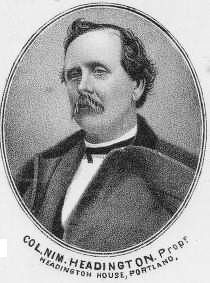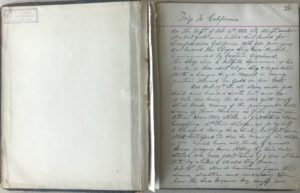It was 1852. Gold was discovered in California a couple years before and young men were rushing to California to stake their claims, hoping to strike it big and make their fortunes.
This was also the dream of one of my ancestors, Nimrod Headington.
Nimrod Headington was the son of Nicholas (1790-1856) and Ruth (Phillips) (1794-1865) Headington. Nimrod was born in Mt. Vernon, Knox County, Ohio, on 5 August 1827, and moved to Portland, Jay County, Indiana, by 1860. He served in the 34th Indiana Infantry during the Civil War as a Colonel, Lieutenant Colonel, and Major. Nimrod died 7 January 1913 and is buried in Green Park Cemetery, Portland. Nimrod Headington is my fourth great-granduncle, the brother of my fourth great-grandfather, William Headington (1815-1879). [1]
Nimrod married Mary Ann McDonald (1829-1855) in Delaware County, Ohio, in 1849. [2] They had a son a year later. Despite the fact that he had just started a family, Nimrod took off for California in February of 1852, hoping to stake his claim on a profitable gold mine. As were so many others, he was hoping to strike it rich. In February of 1852 he traveled to New York, where he boarded a ship bound for San Francisco, sailing all the way around the tip of South America to get there. This was before the Panama Canal was constructed and was evidently a good way to get to California from the east coast.
One of the best things about Nimrod’s journey is that he kept a journal of his travel by ship to California and of his time in the California gold fields, panning for gold.
Last year a reader shared Nimrod’s journal with me. His late wife Karen (Liffring) was a great-great-granddaughter of Nimrod Headington and she had acquired the original handwritten journal from her father John Liffring. The journal has been in the Liffring family since 1905, when Nimrod made a hand-written a copy for his daughter Thetis O. Tate. Karen (Liffring), who was a book editor, died of cancer in 2010, at age 55. During the last two years of her life she transcribed Nimrod’s journal, which documents his travels between February of 1852 and spring of 1853. [3]
Today begins a series of blog posts, the 1852 journal of Nimrod Headington. I hope you will find the journal as interesting as I do.
START OF THE TRIP
On the night of February 16th, 1852, we weighed anchor at New York and hoisted sail bound for San Francisco, California, with 330 passengers on board the clipper ship Race Hound. Commanded by Captain Copeland, the ship was a beautiful specimen of her kind: a three-mast clipper ship and copper bottom with a larger-sized hound in running position trimmed in gold on her bow.
On February 17th, we were under full sail and headed southeast and ran 13 knots per hour. The sea was quite rough, which made many of the passengers sea sick—some of them moaning as if in great pain, others vomiting, while a few others were laughing at their distress. As for myself, I escaped being seasick but felt somewhat distressed to see so many in distress. You could hear all kinds of remarks—some praying, some wishing they had never started. One poor fellow said, “If I was at home with my mother, I would stay there!”
February 18th. The wind continued from the same direction and increasing every hour. The sea became very rough and the waves ran high, and occasionally a spray would dash over the side or bow of the ship, wetting those on deck all over. Then those that escaped would roar with laughter while those who got soaked would hunt for dry clothing.
The wind and the weather continued about the same until Saturday, February 19th, when we struck the trade winds. The wind changed and came from the west, and the sea ran down, and the passengers began to recover from their seasickness.
Sunday came, and it was a beautiful day. The sun shown so brightly on the deep blue water. No land in sight. It was warm and pleasant on deck, and everyone that was able to crawl was on deck. We had some notebooks, and we enjoyed the day in singing, making little speeches, and telling stories. There were quite a number of good singers and some musicians in our company, several violins, and some horns.
About eight o’clock that night, the wind changed to the northwest and blowed tremendous hard at ten o’clock. Our top mast and main [topgallant] mast was carried away by the storm. This left us in a very bad condition. The ship presented a horrible and pitiful-looking spectacle. Many of our passengers were considerably frightened, and I will not say that I felt at all easy over our situation. I made it a point to watch and converse with the sailors. They are so very harshly treated by the ship’s officers that they are glad to talk to anyone who will talk kindly to them, and when I could see that they were not frightened, it made me feel better, as I was not seasick any. I had good opportunities to talk with them when they were not busy.
This storm continued until Wednesday, the 25th, when it cleared up and was pleasant, but the sea waves ran high for several hours. The sailors all hands went to work, taking down the broken spars and ropes and preparing to erect new ones.
On the 26th, a Mrs. Bresler, the wife of a merchant of Philadelphia, Pennsylvania, died. She was on her way to join her husband, who had gone to California a few months before. The funeral service was led by the ship’s captain, and she was buried the same day. There being no minister on board, it is the duty of the captain to officiate. He read the 15th chapter of Corinthians and a few of us gathered around the corpse as it lay on the plank, ready to be lowered into the sea and sang “Jesus, Lover of My Soul.” This was a sad sight for those who had never been to sea.
February 27th. The sea has run down. The day is pleasant and almost calm, which very moves in our favor—being dismasted. It gave the sailors a chance to erect new masts and spars.
February 28th. Two of the ship’s crew got to fighting, and the people on board crowded around. The fighters brought all on one side of the ship until they came very near capsizing us. The captain cried out to trim ship, and a rush was made for the other side, and soon the ship was all right.
To be continued…
I find it interesting that Nimrod mentions the names of people, some of whom died onboard the ship. It makes me wonder if there is any other record of their deaths, or perhaps their families never knew what happened to them.
I will post Nimrod’s journal in increments, but not necessarily every week.
[1] Tombstone Tuesday—Nimrod Headington, Karen’s Chatt, 13 Oct 2013.
[2] “Ohio County Marriages, 1789-2013,” Delaware, Vol. 2, no. 212, Nimrod Headington & Mary Ann McDonald, 22 Nov 1849; online database, FamilySearch.org (https://www.familysearch.org/ark:/61903/3:1:939K-BG9B-6Y?i=93&cc=1614804&personaUrl=%2Fark%3A%2F61903%2F1%3A1%3AX8XB-BF7 : viewed 16 Jan 2020).
[3] Nimrod Headington journal, transcription and photos courtesy of Ross Hill, 2019, used with permission.






8 comments
Skip to comment form
Very interesting! He writes so eloquently compared to compositions I read in this day and age. Thanks so much for sharing this with us. I look forward to reading the next installment.
Author
I agree. He is a very good writer and goes into quite a bit of detail. So good to hear you also find the journal interesting. Thanks for writing.
I like history and especially auto biographies so Nimrod’s story is very interesting. Please keep telling it. I sure wish we had journals of our ancestors.
Author
Yes, old journals can give us a lot of information, and such a shame that most of our ancestors did not write journals. Nimrod’s journal is a real treasure and covers several aspects of that time period. Thanks for writing and I am sure you will enjoy reading more from his journal.
Thank you for sharing this. My great-great-great grandfather was on Racehound on that journey around the Cape. He wrote a long poem describing his trip and what they encountered which is a great piece of our family history. The work you publish is an excellent commentary to bring details to our poem. I now know so much more about his story and what the trip must have been like.
Author
How interesting! I would love to read his poem. Is is published somewhere? What was your gr-gr-gr-grandfather’s name? Thanks for writing!
Nimrod would be my 4th Great Uncle. Very interesting to learn a lot of this. I would love to someday read this journal.
Author
Great to learn of another cousin! Nimrod’s entire journal is posted here, on Karen’s Chatt, broken up into a series of blog posts. He kept a very informative journal. Thanks for writing!